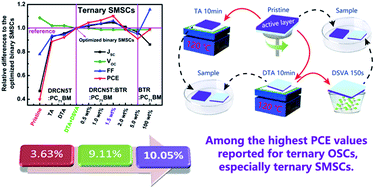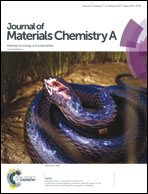Nematic liquid crystal materials as a morphology regulator for ternary small molecule solar cells with power conversion efficiency exceeding 10%†
Abstract
Solution-processed small molecule solar cells (SMSCs) are fabricated based on DRCN5T:PC71BM as active layers, the power conversion efficiency (PCE) is markedly increased from 3.63% to 9.11% for the active layers undergoing up-side-down thermal annealing and solvent vapor annealing post-treatments. The PCE improvement should be attributed to the appropriate phase separation consisting of enhanced crystallinity of donor and purified acceptor domain at nanoscale. The nematic liquid crystal small molecule BTR is selected as the second donor and morphology regulator to prepare ternary SMSCs. The champion PCE of ternary SMSCs was improved to 10.05% by mixing 1.5 wt% BTR, which corresponds to a 10.3% PCE improvement compared with the optimized binary SMSCs. The performance improvement is mainly attributed to the further optimized phase separation and complementary photon harvesting between DRCN5T and BTR, which could be well demonstrated from absorption spectra, two dimensional grazing incidence X-ray diffraction (2D-GIXD) and transmission electron microscopy (TEM).



 Please wait while we load your content...
Please wait while we load your content...